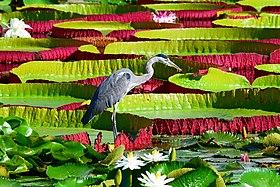
| Flowering plant families (APG IV) | |||||
|---|---|---|---|---|---|
|
|
|||||
| Early-diverging flowering plants | |||||
| Monocots: Alismatids • Commelinids • Lilioids | |||||
|
|
|||||
Eudicots
|
There are 27 families of flowering plants whose earliest ancestors diverged from what became the two most prominent groups of flowering plants, the eudicots and monocots. They are quite diverse, with woody and non-woody plants, evergreen and deciduous shrubs and trees, and plants that grow in soil, in water and on other plants.
Victoria amazonica has the largest undivided leaf of any plant, up to 2.65 m (8 ft 8 in) in diameter. The parasitic genera Hydnora and Prosopanche are the only flowering plants with no evidence of leaves or scales. Myristica fragrans, the source of nutmeg, was important in the 17th-century spice trade. Amborella may represent the earliest-diverging order of flowering plants.
Glossary
From the glossary of botanical terms:
- annual: a plant species that completes its life cycle within a single year or growing season
- basal: attached close to the base (of a plant or an evolutionary tree diagram)
- herbaceous: not woody; usually green and soft in texture
- perennial: not an annual or biennial
- scale: a reduced leaf or a flattened outgrowth
- woody: hard and lignified; not herbaceous
The APG IV system, the fourth in a series of plant taxonomies from the Angiosperm Phylogeny Group, places the early-diverging families in nine orders. Canellales, Laurales, Magnoliales and Piperales are grouped together as the magnoliid orders, with Chloranthales as a sister group. Amborellales, Nymphaeales and Austrobaileyales are the basal angiosperms or the ANA grade. Ceratophyllales may have been the last of the nine orders to diverge, but some fossil evidence links it to the older order Chloranthales.
Families
| Family and a common name | Type genus and etymology | Total genera; global distribution | Description and uses | Order | Type genus images |
|---|---|---|---|---|---|
| Amborellaceae (Amborella family) | Amborella, from a Malagasy plant name | 1 genus, in New Caledonia only | Just one species, Amborella trichopoda, of evergreen shrubs and trees. The wood resembles the softwood of conifers, rather than hardwood. | Amborellales |   Amborella trichopoda Amborella trichopoda
|
| Annonaceae (soursop family) | Annona, from a Taíno plant name | 111 genera, throughout the tropics, with 2 genera in eastern North America | Shrubs, large trees and woody vines with fibrous bark. Several Annona and Asimina species are grown for their fruit, and Cananga odorata is used in perfumes. | Magnoliales |   Annona muricata Annona muricata
|
| Aristolochiaceae (birthwort family) | Aristolochia, from Greek for "best childbirth" | 8 genera, worldwide | Herbaceous perennials with rhizomes, shrubs, small trees and woody vines. Some Aristolochia, Asarum and Saruma species can be grown as garden ornamentals. | Piperales |   Aristolochia rotunda Aristolochia rotunda
|
| Atherospermataceae (southern-sassafras family) | Atherosperma, from Greek for "awned seeds" or "pointed fruit" | 6 genera, in and around the South Pacific | Scented shrubs and trees. Laurelia sempervirens fruits are consumed as a spice in South America. | Laurales |   Atherosperma moschatum Atherosperma moschatum
|
| Austrobaileyaceae (Austrobaileya family) | Austrobaileya, for Frederick Manson Bailey (1827–1915) and Irving Widmer Bailey (1884–1967) | 1 genus, in northern Queensland, Australia | Woody vines with smooth leathery leaves | Austrobaileyales |  Austrobaileya scandens Austrobaileya scandens
|
| Cabombaceae (fanwort family) | Cabomba, from a Guianese plant name | 2 genera, scattered worldwide, in fresh water only | Floating herbaceous perennials. Brasenia schreberi is grown as a vegetable in China and Japan. | Nymphaeales |   Cabomba caroliniana Cabomba caroliniana
|
| Calycanthaceae (spicebush family) | Calycanthus, from Greek for "calyx flower" (with similar sepals and petals) | 3 genera, in the US, China and Queensland, Australia. Chimonanthus is cultivated in many countries. | Scented trees and shrubs, with buds covered in scales. Calycanthus oil is used in perfumes, and that genus and Chimonanthus are cultivated for their scented flowers. | Laurales |   Calycanthus floridus Calycanthus floridus
|
| Canellaceae (canela-bark family) | Canella, from Canna and Latin for "little" | 5 genera, in the Americas and eastern and southern Africa | Trees (and some shrubs) with scented leaves. Canella bark is edible, but also used to poison fish. | Canellales |  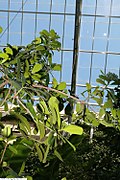 Canella winterana Canella winterana
|
| Ceratophyllaceae (hornwort family) | Ceratophyllum, from Greek for "horned (antler-shaped) leaves" | 1 genus, in non-salty waterways worldwide | Submerged rootless plants that can anchor themselves with special branches. Some are used in aquariums to maintain oxygen levels. | Ceratophyllales |  Ceratophyllum demersum Ceratophyllum demersum
|
| Chloranthaceae (pearl-orchid family) | Chloranthus, from Greek for "green flowers" | 4 genera, in the tropics, usually on mountain slopes | Scented soft-wooded trees, shrubs and herbaceous plants. Some species of Chloranthus are used in teas. | Chloranthales |   Chloranthus japonicus Chloranthus japonicus
|
| Degeneriaceae (masiratu family) | Degeneria, for Otto Degener (1899–1988) | 1 genus, only in Fiji | Smooth scented trees with spirally arranged leaves | Magnoliales | — |
| Eupomatiaceae (bolwarra family) | Eupomatia, from Greek for "well-capped" | 1 genus, in New Guinea and eastern Australia | Shrubs, and a few trees, with root tubers and scented leaves. Eupomatia laurina fruit is an ingredient in jams, desserts and juices. | Magnoliales |   Eupomatia laurina Eupomatia laurina
|
| Gomortegaceae (keule family) | Gomortega, for Casimiro Gómez Ortega (1741–1818) | 1 genus, only in the coastal mountains of southern Chile | Just one species of scented evergreen trees. Keule fruit is prized in Chile. | Laurales |   Gomortega keule Gomortega keule
|
| Hernandiaceae (lantern-tree family) | Hernandia, for Francisco Hernández de Toledo (1514–1587) | 4 genera, mostly in tropical lowlands | Shrubs, trees and woody vines. Gyrocarpus is a source of lightweight timber. | Laurales |   Hernandia nymphaeifolia Hernandia nymphaeifolia
|
| Himantandraceae (pigeonberry-ash family) | Galbulimima. Himantandra, an earlier synonym, is from Greek for "strap-like male parts". | 1 genus, in Melanesia and eastern Australia | Scented trees with coppery-haired leaves. The wood is used for timber. | Magnoliales |   Galbulimima belgraveana Galbulimima belgraveana
|
| Hydatellaceae (watertufts family) | Trithuria. Hydatella, an earlier synonym, is from Greek for "little water" (plant). | 1 genus, in New Zealand, Australia and India | Tiny, usually aquatic plants with rhizomes | Nymphaeales |  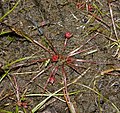 Trithuria submersa Trithuria submersa
|
| Lauraceae (bay-laurel family) | Laurus, from a Latin plant name | 56 genera, throughout the tropics, with a few species in temperate zones | Scented shrubs and trees, except for the parasitic genus Cassytha. Avocado is a staple food crop, and many other species have edible parts. | Laurales |   Laurus nobilis Laurus nobilis
|
| Magnoliaceae (tuliptree family) | Magnolia, for Pierre Magnol (1638–1715) | 2 genera, scattered in Brazil and in generally eastern and southeastern regions of both Asia and North America | Shrubs and trees with deciduous leaves that enclose the often large flower buds. Many species are popular garden ornamentals, and some of the scented oils are used in perfumes. | Magnoliales |   Magnolia virginiana Magnolia virginiana
|
| Monimiaceae (boldo family) | Monimia, for Monime (d. 71 BC), a queen of Pontus | 27 genera, scattered in the tropics, with some genera in temperate forests of the Southern Hemisphere | Scented shrubs, trees and woody vines. The leaves and fruits of Peumus boldus (boldo) are edible. Some species produce good timber. | Laurales |  A Monimia species A Monimia species
|
| Myristicaceae (nutmeg family) | Myristica, from Greek for an ointment | 21 genera, all in the tropics | Scented trees and shrubs with red sap. The spice nutmeg can be addictive and toxic in large doses, but the oil is used medicinally and as a toothpaste additive. | Magnoliales | 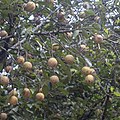 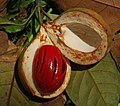 Myristica fragrans Myristica fragrans
|
| Nymphaeaceae (waterlily family) | Nymphaea, from Greek for "water nymphs" | 5 genera, widespread in shallow tropical and temperate waterways | Aquatic herbaceous plants, often with edible seeds and rhizomes. They are cultivated around the world as pond and aquarium ornamentals and for their nutritional value. | Nymphaeales |   Nymphaea alba Nymphaea alba
|
| Piperaceae (pepper family) | Piper, from a Latin plant name, originally from Sanskrit and Greek | 5 genera, widespread in the tropics and subtropics | Shrubs, trees, woody vines and herbaceous plants, many with scented leaves. Some species grow on other plants. Black pepper, now grown around the world, was the first trading commodity of the East Indies in the 16th and 17th centuries. | Piperales |   Piper nigrum Piper nigrum
|
| Saururaceae (lizard's-tail family) | Saururus, from Greek for "lizard tail" | 4 genera, in East and Southeast Asia, and in the US | Scented herbaceous perennials with rhizomes. Houttuynia cordata, a fishy-tasting vegetable, is consumed in China. | Piperales |  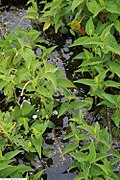 Saururus cernuus Saururus cernuus
|
| Schisandraceae (star-anise family) | Schisandra, from Greek for "divided male parts" (the anthers) | 3 genera, in eastern Asia, with one species in the southeastern US | Shrubs, small trees and woody vines with scented leaves. Some fruits are made into jams and juices. Fruits of Illicium verum (star anise) are used as a spice and processed pharmaceutically for the antiviral drug Tamiflu. | Austrobaileyales |   Schisandra rubriflora Schisandra rubriflora
|
| Siparunaceae (fevertree family) | Siparuna, from a Guianese plant name | 2 genera, in the tropics of West Africa and the Americas | Small trees, shrubs and a few woody vines | Laurales |   Siparuna guianensis Siparuna guianensis
|
| Trimeniaceae (bittervine family) | Trimenia, for Henry Trimen (1843–1896) | 1 genus, in eastern Australia, Sulawesi, Melanesia and Polynesia | Shrubs, trees and woody vines | Austrobaileyales |  Trimenia weinmanniifolia Trimenia weinmanniifolia
|
| Winteraceae (Winter's-bark family) | Wintera, for John Winter (16th century), a ship captain | 5 genera, scattered in the Americas, Madagascar, and in and around the southwestern Pacific | Scented trees and shrubs with a few woody vines, some growing on other plants. Tasmannia species are grown as pepper substitutes. Drimys winteri was an effective scurvy remedy in the 17th and 18th centuries. | Canellales | 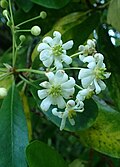 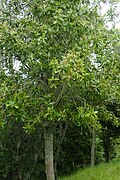 Drimys winteri Drimys winteri
|
See also
Notes
- The taxonomy (classification) in this list follows Plants of the World (2017) and the fourth Angiosperm Phylogeny Group system. Total counts of genera for each family come from Plants of the World Online. (See the POWO license.) Extinct taxa are not included.
- Each family's formal name ends in the Latin suffix -aceae and is derived from the name of a genus that is or once was part of the family.
- Some plants were named for naturalists (unless otherwise noted).
Citations
Some of POWO's data originally appeared in different databases. On the page for each family, these databases (if any) will appear under the "General information" tab.
- Christenhusz, Fay & Chase 2017, pp. 10–11.
- Christenhusz, Fay & Chase 2017.
- Angiosperm Phylogeny Group 2016.
- POWO.
- ^ Christenhusz, Fay & Chase 2017, pp. 87–114.
- Christenhusz, Fay & Chase 2017, pp. 88, 91, 100–102.
- Christenhusz, Fay & Chase 2017, pp. 638–670.
- Christenhusz, Fay & Chase 2017, pp. 10.
- Qiu et al 1999, p. 404.
- Christenhusz, Fay & Chase 2017, pp. 10, 212.
- ICN, art. 18.
- ^ Christenhusz, Fay & Chase 2017, p. 88.
- Philipson 1993, p. 93.
- POWO, Amborellaceae.
- Philipson 1993, pp. 92–93.
- Stearn 2002, p. 45.
- IPNI, Annonaceae, Type.
- Kessler 1993, p. 103.
- POWO, Annonaceae.
- Kessler 1993, p. 93.
- ^ POWO, Flora of Zambesiaca.
- ^ Christenhusz, Fay & Chase 2017, pp. 105–106.
- Stearn 2002, p. 51.
- Coombes 2012, p. 50.
- IPNI, Aristolochiaceae, Type.
- Huber 1993, p. 133.
- POWO, Aristolochiaceae.
- POWO, Flora of Somalia.
- ^ Christenhusz, Fay & Chase 2017, pp. 100–101.
- Huber 1993, p. 129.
- ^ Christenhusz, Fay & Chase 2017, p. 109.
- Stearn 2002, p. 55.
- IPNI, Atherosperma.
- ^ POWO, Atherospermataceae.
- ^ Christenhusz, Fay & Chase 2017, p. 92.
- Endress 1993, p. 140.
- POWO, Austrobaileyaceae.
- Endress 1993, p. 138.
- Stearn 2002, p. 75.
- IPNI, Cabombaceae, Type.
- Williamson & Schneider 1993, p. 160.
- POWO, Cabombaceae.
- ^ POWO, Flora of Tropical East Africa.
- ^ Christenhusz, Fay & Chase 2017, p. 90.
- Williamson & Schneider 1993, p. 157.
- Stearn 2002, p. 78.
- Coombes 2012, p. 78.
- IPNI, Calycanthaceae, Type.
- Kubitzki 1993, p. 199.
- POWO, Calycanthaceae.
- ^ Christenhusz, Fay & Chase 2017, p. 107.
- Kubitzki 1993, p. 197.
- Stearn 2002, p. 80.
- IPNI, Canellaceae, Type.
- Kubitzki 1993, pp. 202–203.
- POWO, Canellaceae.
- ^ Christenhusz, Fay & Chase 2017, p. 95.
- Kubitzki 1993, p. 200.
- Stearn 2002, p. 88.
- Coombes 2012, p. 89.
- Les 1993, pp. 248–249.
- POWO, Ceratophyllaceae.
- ^ Christenhusz, Fay & Chase 2017, p. 212.
- ^ POWO, Flora of West Tropical Africa.
- Les 1993, p. 246.
- Bayton 2020, p. 84.
- IPNI, Chloranthaceae, Type.
- Todzia 1993, p. 285.
- POWO, Chloranthaceae.
- ^ POWO, Neotropikey.
- ^ Christenhusz, Fay & Chase 2017, p. 114.
- Todzia 1993, p. 281.
- Burkhardt 2018, p. D-18.
- Kubitzki 1993, p. 291.
- POWO, Degeneriaceae.
- ^ Christenhusz, Fay & Chase 2017, p. 104.
- Kubitzki 1993, p. 290.
- ^ Christenhusz, Fay & Chase 2017, p. 105.
- Endress 1993, p. 298.
- POWO, Eupomatiaceae.
- Endress 1993, p. 296.
- Burkhardt 2018, p. G-33.
- Kubitzki 1993, p. 320.
- POWO, Gomortegaceae.
- ^ Christenhusz, Fay & Chase 2017, pp. 108–109.
- Kubitzki 1993, p. 318.
- Quattrocchi 2000, p. 1205.
- IPNI, Hernandiaceae, Type.
- Kubitzki 1993, p. 337.
- POWO, Hernandiaceae.
- ^ Christenhusz, Fay & Chase 2017, p. 110.
- Kubitzki 1993, p. 334.
- POWO, Himantandra.
- Endress 1993, p. 340.
- POWO, Himantandraceae.
- Endress 1993, p. 338.
- ^ Christenhusz, Fay & Chase 2017, p. 89.
- POWO, Hydatella.
- POWO, Hydatellaceae.
- Stearn 2002, p. 186.
- Coombes 2012, p. 186.
- IPNI, Lauraceae, Type.
- Rohwer 1993, p. 376.
- POWO, Lauraceae.
- ^ Christenhusz, Fay & Chase 2017, pp. 112–113.
- Rohwer 1993, p. 366.
- ^ Christenhusz, Fay & Chase 2017, p. 103.
- IPNI, Magnoliaceae, Type.
- POWO, Magnoliaceae.
- Nooteboom 1993, p. 391.
- Burkhardt 2018, p. M-65.
- IPNI, Monimiaceae, Type.
- Philipson 1993, p. 430.
- POWO, Monimiaceae.
- ^ Christenhusz, Fay & Chase 2017, p. 111.
- Philipson 1993, p. 426.
- ^ Christenhusz, Fay & Chase 2017, p. 102.
- IPNI, Myristicaceae, Type.
- Kühn & Kubitzki 1993, p. 463.
- POWO, Myristicaceae.
- Kühn & Kubitzki 1993, p. 457.
- Stearn 2002, p. 220.
- Coombes 2012, p. 215.
- IPNI, Nymphaeaceae, Type.
- Schneider & Williamson 1993, p. 489.
- POWO, Nymphaeaceae.
- Schneider & Williamson 1993, pp. 486, 489.
- ^ Christenhusz, Fay & Chase 2017, p. 91.
- ^ Christenhusz, Fay & Chase 2017, p. 99.
- Stearn 2002, p. 241.
- IPNI, Piperaceae, Type.
- Tebbs 1993, p. 518.
- POWO, Piperaceae.
- Tebbs 1993, p. 516.
- Stearn 2002, p. 268.
- IPNI, Saururaceae, Type.
- Wu Cheng-Yih & Kubitzki 1993, p. 587.
- POWO, Saururaceae.
- ^ Christenhusz, Fay & Chase 2017, p. 98.
- Wu Cheng-Yih & Kubitzki 1993, p. 586.
- Stearn 2002, p. 269.
- Coombes 2012, p. 268.
- IPNI, Schisandraceae, Type.
- Keng 1993, p. 591.
- POWO, Schisandraceae.
- ^ Christenhusz, Fay & Chase 2017, pp. 93–94.
- Keng 1993, p. 589.
- ^ Christenhusz, Fay & Chase 2017, p. 108.
- IPNI, Siparuna.
- ^ POWO, Siparunaceae.
- Burkhardt 2018, p. T-37.
- Philipson 1993, p. 598.
- POWO, Trimeniaceae.
- ^ Christenhusz, Fay & Chase 2017, p. 93.
- Philipson 1993, p. 596.
- Burkhardt 2018, p. W-31.
- IPNI, Winteraceae, Type.
- Vink 1993, p. 637.
- POWO, Winteraceae.
- ^ Christenhusz, Fay & Chase 2017, p. 96.
- Vink 1993, p. 630.
References
- Angiosperm Phylogeny Group (2016). "An update of the Angiosperm Phylogeny Group classification for the orders and families of flowering plants: APG IV". Botanical Journal of the Linnean Society. 181 (1): 1–20. doi:10.1111/boj.12385.
- Bayton, Ross (2020). The Gardener's Botanical: An Encyclopedia of Latin Plant Names. Princeton, New Jersey: Princeton University Press. ISBN 978-0-691-20017-0.
- Burkhardt, Lotte (2018). Verzeichnis eponymischer Pflanzennamen – Erweiterte Edition [Index of Eponymic Plant Names – Extended Edition] (pdf) (in German). Berlin: Botanic Garden and Botanical Museum, Freie Universität Berlin. doi:10.3372/epolist2018. ISBN 978-3-946292-26-5. S2CID 187926901. Retrieved January 1, 2021. See the Creative Commons license.
- Christenhusz, Maarten; Fay, Michael Francis; Chase, Mark Wayne (2017). Plants of the World: An Illustrated Encyclopedia of Vascular Plants. Chicago, Illinois: Kew Publishing and The University of Chicago Press. ISBN 978-0-226-52292-0.
- Coombes, Allen (2012). The A to Z of Plant Names: A Quick Reference Guide to 4000 Garden Plants. Portland, Oregon: Timber Press. ISBN 978-1-60469-196-2.
- Endress, P. K. (1993). "Austrobaileyaceae, Eupomatiaceae, Himantandraceae". In Kubitzki, K.; Rohwer, J. G.; Bittrich, V. (eds.). The Families and Genera of Vascular Plants. II Flowering plants - Dicotyledons. Magnoliid, Hamamelid and Caryophyllid families. Vol. II. Berlin: Springer Science+Business Media. pp. 138, 140, 296, 298, 338, 340. ISBN 3-540-55509-9.
- Huber, H. (1993). "Aristolochiaceae". In Kubitzki, K.; Rohwer, J. G.; Bittrich, V. (eds.). The Families and Genera of Vascular Plants. II Flowering plants - Dicotyledons. Magnoliid, Hamamelid and Caryophyllid families. Vol. II. Berlin: Springer Science+Business Media. pp. 129, 133. ISBN 3-540-55509-9.
- IPNI (2022). "International Plant Names Index". London, Boston and Canberra: Royal Botanic Gardens, Kew; Harvard University Herbaria & Libraries; and the Australian National Botanic Gardens. Retrieved December 20, 2022.
- Keng, H. (1993). "Schisandraceae". In Kubitzki, K.; Rohwer, J. G.; Bittrich, V. (eds.). The Families and Genera of Vascular Plants. II Flowering plants - Dicotyledons. Magnoliid, Hamamelid and Caryophyllid families. Vol. II. Berlin: Springer Science+Business Media. pp. 589, 591. ISBN 3-540-55509-9.
- Kessler, P. J. A. (1993). "Annonaceae". In Kubitzki, K.; Rohwer, J. G.; Bittrich, V. (eds.). The Families and Genera of Vascular Plants. II Flowering plants - Dicotyledons. Magnoliid, Hamamelid and Caryophyllid families. Vol. II. Berlin: Springer Science+Business Media. pp. 93, 103. ISBN 3-540-55509-9.
- Kubitzki, K. (1993). "Calycanthaceae, Canellaceae, Degeneriaceae, Gomortegaceae, Hernandiaceae". In Kubitzki, K.; Rohwer, J. G.; Bittrich, V. (eds.). The Families and Genera of Vascular Plants. II Flowering plants - Dicotyledons. Magnoliid, Hamamelid and Caryophyllid families. Vol. II. Berlin: Springer Science+Business Media. pp. 197, 199, 200, 202, 203, 290, 291, 318, 320, 334, 337. ISBN 3-540-55509-9.
- Kühn, U.; Kubitzki, K. (1993). "Myristicaceae". In Kubitzki, K.; Rohwer, J. G.; Bittrich, V. (eds.). The Families and Genera of Vascular Plants. II Flowering plants - Dicotyledons. Magnoliid, Hamamelid and Caryophyllid families. Vol. II. Berlin: Springer Science+Business Media. pp. 457, 463. ISBN 3-540-55509-9.
- Les, D. H. (1993). "Ceratophyllaceae". In Kubitzki, K.; Rohwer, J. G.; Bittrich, V. (eds.). The Families and Genera of Vascular Plants. II Flowering plants - Dicotyledons. Magnoliid, Hamamelid and Caryophyllid families. Vol. II. Berlin: Springer Science+Business Media. pp. 246, 248, 249. ISBN 3-540-55509-9.
- Nooteboom, H. P. (1993). "Magnoliaceae". In Kubitzki, K.; Rohwer, J. G.; Bittrich, V. (eds.). The Families and Genera of Vascular Plants. II Flowering plants - Dicotyledons. Magnoliid, Hamamelid and Caryophyllid families. Vol. II. Berlin: Springer Science+Business Media. p. 391. ISBN 3-540-55509-9.
- Philipson, W. R. (1993). "Amborellaceae, Monimiaceae, Trimeniaceae". In Kubitzki, K.; Rohwer, J. G.; Bittrich, V. (eds.). The Families and Genera of Vascular Plants. II Flowering plants - Dicotyledons. Magnoliid, Hamamelid and Caryophyllid families. Vol. II. Berlin: Springer Science+Business Media. pp. 92, 93, 426, 430, 596, 598. ISBN 3-540-55509-9.
- POWO (2019). "Plants of the World Online". London: Royal Botanic Gardens, Kew. Retrieved January 1, 2023. See their terms-of-use license.
- Quattrocchi, Umberto (2000). CRC World Dictionary of Plant Names, Volume II, D–L. Boca Raton, Florida: CRC Press. ISBN 978-0-8493-2676-9.
- Rohwer, J. G. (1993). "Lauraceae". In Kubitzki, K.; Rohwer, J. G.; Bittrich, V. (eds.). The Families and Genera of Vascular Plants. II Flowering plants - Dicotyledons. Magnoliid, Hamamelid and Caryophyllid families. Vol. II. Berlin: Springer Science+Business Media. pp. 366, 376. ISBN 3-540-55509-9.
- Schneider, E. L.; Williamson, P. S. (1993). "Nymphaeaceae". In Kubitzki, K.; Rohwer, J. G.; Bittrich, V. (eds.). The Families and Genera of Vascular Plants. II Flowering plants - Dicotyledons. Magnoliid, Hamamelid and Caryophyllid families. Vol. II. Berlin: Springer Science+Business Media. pp. 486, 489. ISBN 3-540-55509-9.
- Stearn, William (2002). Stearn's Dictionary of Plant Names for Gardeners. London: Cassell. ISBN 978-0-304-36469-5.
- Tebbs, M. C. (1993). "Piperaceae". In Kubitzki, K.; Rohwer, J. G.; Bittrich, V. (eds.). The Families and Genera of Vascular Plants. II Flowering plants - Dicotyledons. Magnoliid, Hamamelid and Caryophyllid families. Vol. II. Berlin: Springer Science+Business Media. pp. 516, 518. ISBN 3-540-55509-9.
- Todzia, C. A. (1993). "Chloranthaceae". In Kubitzki, K.; Rohwer, J. G.; Bittrich, V. (eds.). The Families and Genera of Vascular Plants. II Flowering plants - Dicotyledons. Magnoliid, Hamamelid and Caryophyllid families. Vol. II. Berlin: Springer Science+Business Media. pp. 281, 285. ISBN 3-540-55509-9.
- Turland, N. J.; et al. (eds.). International Code of Nomenclature for algae, fungi, and plants (Shenzhen Code) adopted by the Nineteenth International Botanical Congress Shenzhen, China, July 2017 (electronic ed.). Glashütten: International Association for Plant Taxonomy. Retrieved February 25, 2022.
- Williamson, P. S.; Schneider, E. L. (1993). "Cabombaceae". In Kubitzki, K.; Rohwer, J. G.; Bittrich, V. (eds.). The Families and Genera of Vascular Plants. II Flowering plants - Dicotyledons. Magnoliid, Hamamelid and Caryophyllid families. Vol. II. Berlin: Springer Science+Business Media. pp. 157, 160. ISBN 3-540-55509-9.
- Vink, W. (1993). "Winteraceae". In Kubitzki, K.; Rohwer, J. G.; Bittrich, V. (eds.). The Families and Genera of Vascular Plants. II Flowering plants - Dicotyledons. Magnoliid, Hamamelid and Caryophyllid families. Vol. II. Berlin: Springer Science+Business Media. pp. 630, 637. ISBN 3-540-55509-9.
- Wu Cheng-Yih; Kubitzki, K. (1993). "Saururaceae". In Kubitzki, K.; Rohwer, J. G.; Bittrich, V. (eds.). The Families and Genera of Vascular Plants. II Flowering plants - Dicotyledons. Magnoliid, Hamamelid and Caryophyllid families. Vol. II. Berlin: Springer Science+Business Media. pp. 586, 587. ISBN 3-540-55509-9.
- Yin-Long Qiu; Jungho Lee; Fabiana Bernasconi-Quadroni; Douglas E. Soltis; Pamela S. Soltis; Michael Zanis; Elizabeth A. Zimmer; Zhiduan Chen; Vincent Savolainen; Mark W. Chase (1999). "The earliest angiosperms: Evidence from mitochondrial, plastid and nuclear genomes". Nature. 402 (6760): 404–407. Bibcode:1999Natur.402..404Q. doi:10.1038/46536. PMID 10586879. S2CID 4380796.
| Orders of flowering plants (APG IV) | ||||||||||||||||||||||||||||||||||||||||||||||||||
|---|---|---|---|---|---|---|---|---|---|---|---|---|---|---|---|---|---|---|---|---|---|---|---|---|---|---|---|---|---|---|---|---|---|---|---|---|---|---|---|---|---|---|---|---|---|---|---|---|---|---|
| Angiosperms |
|  | ||||||||||||||||||||||||||||||||||||||||||||||||